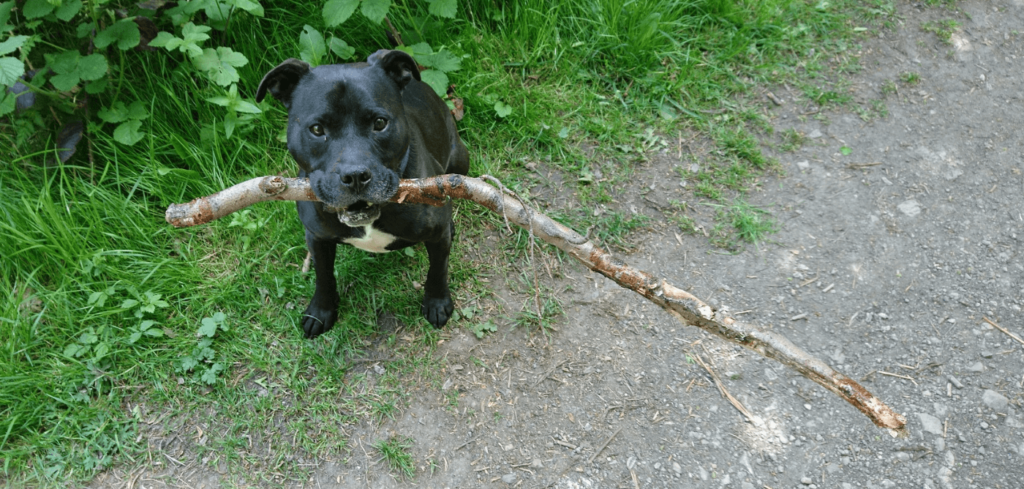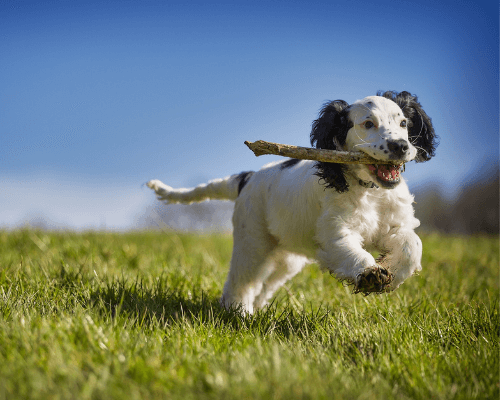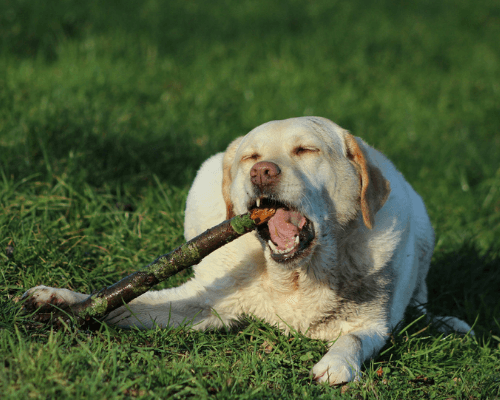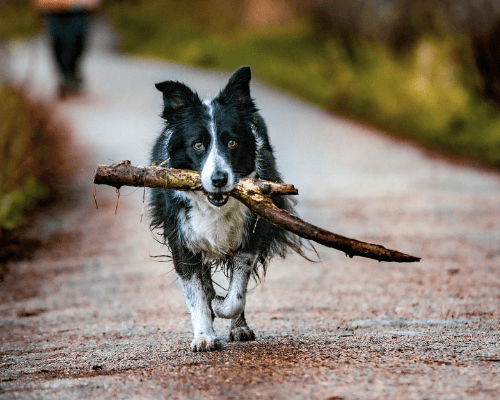
With all of the scholarly research out there, you would think that someone would have calculated by now the average number of times a dog owner says, “Drop it!” throughout their dog’s life…
Is that number in the hundreds? Certainly. The thousands? Definitely. Millions? Maybe!
After a while, it can seem tempting to pick-and-choose your battles when it comes to steering your pup away from chewing on things that are off-limits to him…
It seems obvious that most dogs shouldn’t get their teeth on certain types of bones, shoes or socks, or your child’s favorite stuffed toy…
For most dog owners, though, sticks are probably not an item that causes a lot of concern…
After all, many of us have been known to pick up sticks in the park for starting games of fetch during walks, so what is the harm in letting your dog chew on it afterward?
Even for a dog roaming around his yard, his urge to pick up a stick and start gnawing probably seems innocent enough.
Well, it might be surprising to learn that in reality, sticks are not a safe object for dogs to chew on…
There are many reasons why, and in this article, we’ll be covering the following information…
- Why Do Dogs Eat Wood And Sticks?
- Risk Factors – What Happens If A Dog Eats Wood Or A Stick?
- My Dog Ate A Stick! What Do I Do?
- Ways To Stop Your Dog From Eating Sticks In The Future…
In the end, you’ll know why dogs shouldn’t be allowed to eat sticks, and you’ll also know exactly what to do if your dog ate a stick and seems to be displaying odd behavior…
Let’s begin by discussing why dogs eat sticks…

Why Do Dogs Eat Wood And Sticks?
There are a variety of reasons why dogs try to eat sticks, and understanding them is the first step in addressing any underlying issues they may be having to suppress their urges…

Things that can trigger this behavior include…
- Medical Issues
- Hunger
- Boredom
Before considering behavior modification to address a stick-eating issue, it is best to consult with a veterinarian to diagnose any medical conditions your dog may be experiencing…
The vet might explore your dog’s caloric intake, look for deficiencies in essential nutrients, or a digestive disorder…

Sometimes the problem can be something as simple as adding a supplement to your dog’s diet or changing his food to mitigate the issue…
It could also be something more uncommon, such as pica, which is a condition in which your dog has an impulse to eat foreign objects…
Dental issues can also be a trigger for this behavior. We humans, use toothpicks to dislodge material from between our teeth, but wolves and dogs get a natural tooth cleaning by gnawing on bones in the wild…
Dogs will also use this behavior as a self-soothing technique if they are suffering from anxiety or sometimes if they’re simply bored.
Risk Factors – What Happens If A Dog Eats Wood Or A Stick?
One of the reasons why it’s not a good idea to allow your dog to chew or eat sticks is because it can create dental issues and problems inside your dog’s mouth…
Sticks are prone to splintering, and those splinters can lodge themselves into your dog’s gums and teeth as they break off…
This can lead to pain, irritation, infection, and even abscesses in your dog’s mouth, and the end result is not only costly medical expenses for you but tooth removal for your dog!
In addition to that, a dog that ingests sticks can potentially injure his esophagus and intestines. Treating punctures to these internal organs can be tricky, costly, and dangerous…

Digestive tract perforations, for example, are quite serious, and they can result in ongoing bowel problems and even death…
Dogs can also end up with partial airway obstructions, and in certain areas where you or a neighbor have been using chemicals to treat plants or grass, some sticks can have a certain level of toxicity that will cause illness.
My Dog Ate A Stick! What Do I Do?
If you catch your dog eating a stick or if he swallowed a stick whole, the first thing to do is not to panic…
Although there are numerous risk factors associated with eating sticks (and the behavior should be discouraged) there is no cause for alarm unless there are outward signs of trauma…
Next, you’ll want to contact a veterinarian to discuss what happened…

The vet will most likely issue a “wait and see” order and let you know what to look for that might indicate a problem worthy of medical attention…
Some key things to look out for include:
- Indications of pain
- Bleeding from mouth or rectum
- Changes in poop, such as diarrhea
- Vomiting or throwing up
- Coughing
- Unusual behavior
If your dog does start to exhibit any of the behaviors that you should be looking out for, you’ll want to take your dog into the vet as soon as possible…
But if you’ve taken the necessary precautions and are certain that nothing serious has resulted from your dog’s stick-chewing…
…it is best to examine strategies to prevent this behavior from happening again in the future.
Ways To Stop Your Dog From Eating Sticks In The Future…
There are many techniques that you can use to prevent your dog from chewing or eating sticks in the future…
The following are some very effective (and fairly easy) techniques that you can try out…
Modifying The Environment…
The first step in addressing any of your dog’s behavior that you want to change is to modify his environment…
One of the best ways to stop a dog from digging in the kitchen trash can is to take out the garbage, right?

So, inspect your dog’s commonly used areas for sticks, but also look for anything potentially hazardous he could get his teeth on…
For a dog who is bored or anxious, the absence of his usual stick might prompt him to start chewing on something else…
Therefore, if your dog is chewing because of a lack of stimulation or anxiety, you can fill the area with safe toys that he can busy himself with instead…
Dogs enjoy a variety of toys, from nylon bones and hard rubber toys they can gnaw on, to soft plushie toys with squeakers…
Giving your dog some choices will keep him more occupied and hopefully reduce his overall stress.
Nutritional Food Or Supplements…
If your vet has pointed out any potential deficiencies in your dog’s diet or nutritional intake, take the appropriate steps to correct these issues…
Use vet-recommended food or supplements to ensure that your dog’s body has what it needs. This will hopefully reduce any urge to go looking for alternate ways to get nutrients…
If you’re looking for healthy food to give to your dog, I recommend you check out Ollie…
I like Ollie because the meals are tailored specifically for your individual dog and because the food is very nutritional and delivered right to your door…
If you’d like to learn more about how Ollie is some of the best dog food around, click the link below…
>> Click Here To Learn More About Ollie, The Healthy Dog Food That Your Dog Will Love!
Invest In Training…
It’s a really good idea to invest time into training your dog to follow the “leave it” or “drop it” command…
This can actually be one of the most useful and important commands for a dog to know, especially for his or her own safety…

Remember, sticks are not the only hazardous things that dogs are prone to ingest, and it’s incredibly important that your dog actually listens to you when his health and safety are on the line…
If you’d like some help training your dog, I recommend you check out the Brain Training For Dogs program…
I like it because it’s highly effective, easy to follow, and you can go through the program from the comfort of your own home…
If you’d like to learn more about how Brain Training For Dogs can help you train your dog to follow your commands, click the link below…

Trading With Your Dog…
Another creative training technique that you can use involves a game of “trade”. If you catch your dog picking up a stick, offer one of his favorite toys or a treat as a reward for bringing it to you…
Obviously, you’ll want to keep a close eye on your dog if you choose to employ this technique because you don’t want him chewing on sticks when you’re not looking…
But this can end up being a pretty helpful tool to stop your dog from chewing on sticks, and it involves minimal training.
Final Thoughts…
As pet parents, it’s our job to look out for the health and safety of our dogs, and that includes stopping them from eating things that might seem harmless…
Just remember, if your dog does end up eating a stick, be sure to contact a veterinarian and look out for any potential medical issues…
And it’s also a good idea to properly train your dog to follow your commands (such as “leave it”) because, again, this can help keep your dog happy and healthy long into the future.